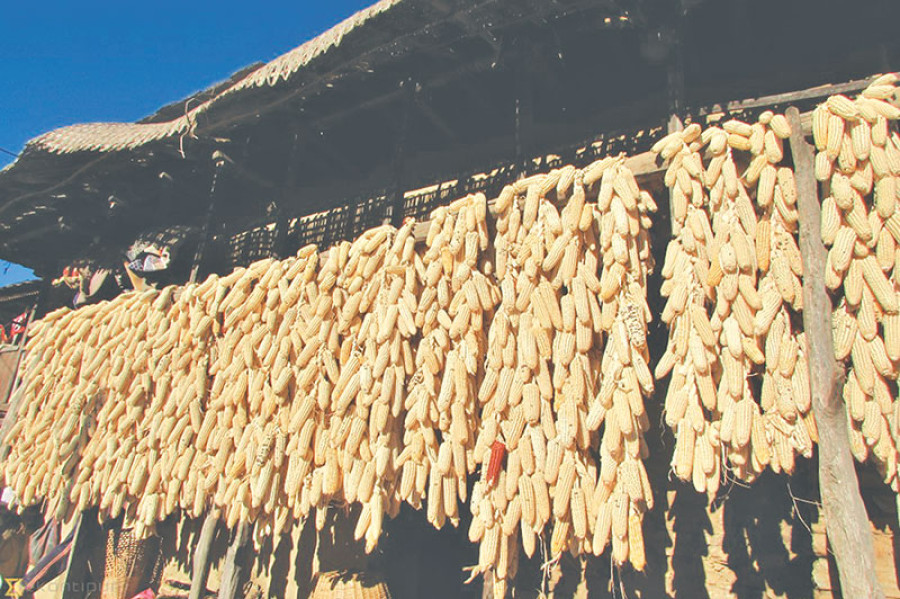Opinion
Craze for maize
Youths need to be included in the mainstreaming of maize improvement research programmes
Dinesh Panday
Globally, maize, also known as corn, is the second most cultivated crop after wheat. In 2017/2018, global maize production was 1045 million metric ton and its production is growing at the rate of 3.5 percent annually. Maize is the staple food for 900 million people living on less than US$2 a day. In Asia, over 310 million metric ton of maize is produced from a harvested field of over 60 million hectares and its production is escalating at 4.5 percent annually. As for Nepal, it produces 1.8 million metric ton of maize every year.
Maize is an important source of carbohydrate, protein, iron, vitamin B, and minerals. It is being used as food, feed, fuel, and fiber purposes. Every part of the maize plant has an economic value: the grain, leaves, stalk, tassel, and cob can all be used to produce a large variety of food and non-food products.
More than 80 percent maize production area in the south and Southeast Asia are under rain-fed conditions, and are vulnerable to climatic extremes, especially in the rainy (or monsoon) season. The magnitude and dynamics of abiotic and biotic stresses are rapidly increasing due to changing climates, placing constraints on maize production.
Recently, an invasive insect pest “fall armyworm” has been reported in India, which can cause a high annual loss in maize production. Such changes in the agricultural landscape in Asia have put further pressure on the efficient use of water, seed/ varieties, and quality of the soil. Farmers in Nepal are attracted to hybrid maize production, but owing to the lack of knowledge in proper nutrient management, targeted yields are not achieved. More important, quality seed availability is the biggest issue in Nepal. The government is able to provide only 10-15 percent of hybrid seed demanded to the farmers.
In many Asian countries including Nepal, commonly practiced soil fertility assessment is based on a random soil sampling protocol to obtain an average fertility value for a farmer’s field. It ignores spatial variability, or those soil-testing results do not provide the randomness of variations from one place to another. And then, soil fertility management recommendations are solely based on soil types and agro-ecological zones. Despite the advisory recommendation made from researches, farmers fail to synchronise fertiliser rates with crop demand, and instead, use mostly acid-forming nitrogenous fertilisers. Hence, there is an urgent need to increase farmers’ awareness regarding the importance and safe use of balanced fertilisers.
Response to these emerging and deep-rooted limitations in maize-based agro-food systems in Asia needs a strong public and private sector partners to improve the livelihoods of smallholder maize farmers. Continued investment in research for development (R4D) is required to ensure higher maize production to meet its future demand. Tremendous opportunities exist for innovations in maize breeding, site-specific nutrient management, seed systems, and value chains, offering exciting prospects for future growth and development of maize. What’s more, there is an increased engagement of women and young entrepreneurs in maize value chains.
Nepali agriculture has a significant involvement of women too. More than 80 percent women work in agriculture for a sustained livelihood. Investing in women and youth, and empowering them through new technologies such as scale appropriate mechanisation, information services, and market opportunities are essential to improve the quality of life in rural families, besides increasing maize production.
Agriculture is taught in schools and colleges. But more often than not, it is portrayed as the option for those who cannot continue in school and/ or those who do not have the capital to go into alternative self-employment. In the absence of sufficient formal education, extension services should play an important role to play in developing young people’s agricultural skills. Policies needs to be designed in such a way that they recognise the role youth play in agricultural production. Further, youths need to be included in mainstreaming maize improvement researches programmes and encourage them to influence positively in farming communities.
Panday is pursuing a doctoral degree in Soil Fertility and Nitrogen Management at University of Nebraska-Lincoln, US.




 16.12°C Kathmandu
16.12°C Kathmandu









%20(1).jpg&w=300&height=200)

